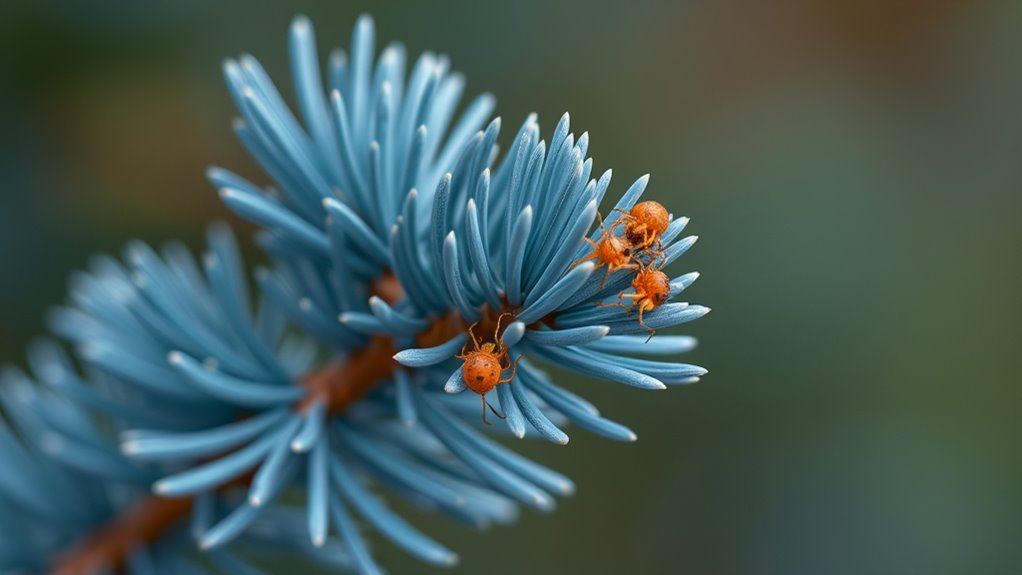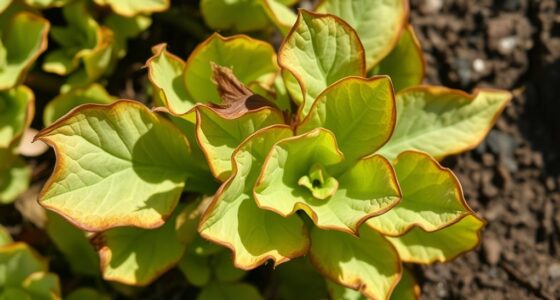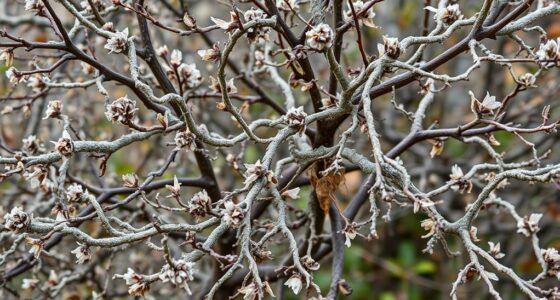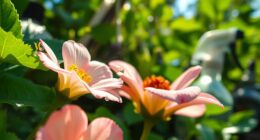If your Blue Arrow juniper turns brown, it could be caused by wind desiccation or spider mites. Wind desiccation often results in uneven browning, starting at the tips, with damage on windward sides. Spider mites create fine webbing and tiny specks on foliage, leading to stippling and uniform browning. Proper inspection of the foliage, branches, and soil can help you identify the cause. Continuing to explore will reveal how to differentiate these issues and apply effective solutions.
Key Takeaways
- Wind desiccation causes uneven browning, starting at needle tips, often on windward sides, with brittle, dry foliage.
- Spider mites produce fine webbing and tiny specks, with stippling or discoloration on needles.
- Check for webbing and moving specks by shaking branches over a white sheet to identify mites.
- Wind damage typically affects outer foliage unevenly, while spider mite damage is more uniform with visible webbing.
- Proper watering, anti-desiccants, and pest monitoring help differentiate and address wind stress versus spider mite infestation.
Recognizing the Signs of Browning in Blue Arrow Junipers

If you notice your Blue Arrow junipers starting to turn brown, it’s important to identify the early signs before the problem worsens. Check the soil moisture around the plant; dry soil often indicates insufficient watering, which can cause browning. Conversely, overly wet soil can lead to root issues. Also, consider wind exposure—strong, persistent winds can dry out the foliage and sap moisture from the plant. Look for uneven browning, starting at the tips or edges of the branches, which can signal dehydration or environmental stress. Early signs may include dull, grayish foliage or brittle needles. Recognizing these symptoms promptly helps you adjust watering practices or provide wind protection, preventing further damage and supporting your junipers’ health. Additionally, understanding the impact of wind desiccation on junipers can help you implement effective mitigation strategies. This process can be exacerbated by environmental stressors, which weaken the plant’s natural defenses and make it more susceptible to browning. Being aware of plant stress responses can guide you in maintaining healthier junipers in challenging conditions.
Understanding Wind Desiccation and Its Effects on Conifers

Wind desiccation occurs when persistent, strong winds strip moisture from conifer foliage faster than the tree can replace it. This process causes needle desiccation, leading to browning and needle loss. Wind stress increases the vulnerability of your junipers, especially during dry or windy periods. As moisture escapes, the tree’s needles dry out and turn brown, often starting at the tips. To visualize this, consider the following:
| Wind Stress | Effects on Conifers | Symptoms |
|---|---|---|
| Persistent wind | Accelerates needle desiccation | Browning and needle drop |
| High wind speed | Reduces moisture retention | Dry, brittle foliage |
| Low humidity | Exacerbates moisture loss | Needle desiccation begins |
Understanding how wind stress impacts your trees helps you manage and protect them from wind-related damage. Being aware of environmental stressors like wind can aid in developing effective care strategies to mitigate damage. Recognizing that wind desiccation can be worsened by other environmental factors, such as low humidity or high winds, allows for more comprehensive prevention efforts. Additionally, proper watering practices can help reduce the effects of wind desiccation by maintaining adequate soil moisture levels.
Identifying Spider Mite Infestations on Junipers

Look closely at your junipers for tiny dots or webbing on the needles, which are signs of spider mites. You might also notice discolored or damaged leaves and needles, indicating their feeding activity. Spotting these signs early can help you take swift action to protect your plants. Additionally, monitoring for plant health signs can help detect infestations before they become severe. Staying informed about AI security vulnerabilities can further enhance your ability to safeguard your garden from invasive pests. Regularly inspecting your junipers and maintaining overall plant health are essential steps in early pest detection to prevent extensive damage.
Visible Webbing and Dots
How can you tell if your juniper is infested with spider mites? Look for visible webbing on the needles and branches, which often appears as fine, silken threads. You might also notice tiny dots—these are the spider mites themselves—moving slowly across the plant’s surface. Webbing can trap dust and debris, making the plant look dusty or flaky. To confirm, gently shake the branches over a white sheet; if you see moving specks, mites are present. Proper pruning techniques help remove heavily infested areas. Additionally, maintaining adequate soil moisture is vital, as drought-stressed junipers are more susceptible to infestations. Regularly inspecting your plant guarantees early detection and easier management of spider mite problems. Using high-quality pest control methods can further help prevent infestations from spreading, and applying natural predators like predatory mites can be an effective, eco-friendly control option. Employing integrated pest management strategies ensures a comprehensive approach to keeping your junipers healthy and pest-free.
Leaf and Needle Damage
When spider mites infest your juniper, you’ll notice damage on the needles and leaves that often appears as tiny, discolored spots or stippling. These specks are caused by mites feeding on plant cells, leading to a faded, scorched look. You might also see needle browning or dieback, especially in the upper canopy. To prevent further damage, guarantee proper soil moisture, as dry conditions stress the plant and make it more vulnerable. Use pruning techniques to remove heavily infested or damaged branches, promoting healthy growth. Regular monitoring helps catch mite activity early. Maintaining adequate soil moisture and practicing proper pruning can reduce the likelihood of mite infestations and keep your juniper healthier and more resilient against damage. Understanding plant stress can help you recognize early signs of infestations and take proactive measures. Additionally, implementing integrated pest management strategies can effectively control mite populations while minimizing chemical use. Recognizing the importance of early detection allows for more targeted and effective treatment approaches.
Comparing Symptoms of Wind Damage and Pest Infestation

When trying to identify whether wind damage or pest infestation is causing your juniper’s browning, look closely at the visual symptoms. Wind typically causes irregular, scattered damage with torn or broken branches, while pests often create more uniform, pattern-like browning. Recognizing these damage patterns helps you determine the true cause and choose the right treatment. Additionally, inspecting the affected areas for signs of pest activity such as webbing or tiny insects can further clarify the situation. Understanding plant health indicators can also assist in diagnosing underlying issues affecting your juniper.
Visual Symptoms Contrast
Wind damage and pest infestation can both cause junipers to turn brown, but their visual symptoms often differ markedly. With wind damage, you may notice uneven browning, especially on exposed branches, along with irregular branch elongation where the plant stretches to recover. The bark texture might appear rougher or cracked due to mechanical stress. In contrast, pest infestations like spider mites typically cause uniform discoloration, with needles turning brown and dying back evenly across the plant. You might see fine webbing or tiny specks on the foliage. Unlike wind damage, pest issues rarely cause significant changes in branch elongation or bark texture unless they become severe. Recognizing these subtle visual clues helps you distinguish between environmental stress and pest problems. Regular inspection and proper grooming can help identify early signs of pest activity before severe damage occurs. Additionally, understanding the symptoms of pest infestation can aid in prompt treatment to protect your juniper. Being aware of plant stress signs can further assist in differentiating between causes of browning and ensure appropriate care.
Damage Patterns Differ
Damage patterns in junipers reveal clear differences between wind stress and pest infestations. Wind damage typically causes irregular browning, often on the windward side, with needle tips turning brown due to dehydration. You might notice uneven soil moisture levels nearby, as wind accelerates moisture loss. In contrast, pest infestations like spider mites produce fine webbing and tiny discolored spots, often starting at the plant’s base or inner foliage. Pest damage tends to be more localized, with healthy tissue surrounding affected areas. Pruning techniques can help remove damaged limbs, but proper soil moisture management is essential for recovery. While wind causes broad, uneven browning, pest damage features distinct patterns of tiny specks and webbing. Recognizing these patterns helps you diagnose and address the problem effectively.
Conducting a Visual Inspection for Pests and Environmental Damage

To identify issues affecting your juniper, start by thoroughly inspecting the foliage, branches, and trunk for signs of pests or environmental stress. Look for discoloration, webbing, or tiny insects like spider mites, which can cause browning. Check soil moisture levels around the plant, as either overly dry or waterlogged soil can stress the juniper, leading to browning. Examine your pruning techniques to ensure you’re not removing too much foliage or damaging the branches, which can make the plant more vulnerable. Observe for any physical damage or unusual growth patterns. A careful visual check helps you determine whether pests, like spider mites, or environmental factors are contributing to the browning, guiding your next steps for proper care.
Assessing Environmental Conditions Contributing to Browning

Environmental factors can considerably influence the health of your juniper and may be a key reason for browning. First, check the soil moisture around your plant. If the soil is too dry, your juniper can become stressed and begin to brown. Conversely, overly wet soil can lead to root issues, also causing browning needles. Next, evaluate air circulation around the juniper. Poor airflow traps humidity and prevents the plant from drying out excess moisture, increasing vulnerability to pests and disease. Ensure your juniper isn’t crowded by other plants or structures that limit air movement. Proper soil moisture levels and good air circulation are essential for maintaining a healthy, vibrant juniper. Addressing these environmental conditions can help reduce browning and promote overall plant resilience.
Natural and Chemical Treatments for Wind Desiccation Damage

Wind desiccation can leave juniper needles dry, brown, and damaged, but there are effective natural and chemical treatments to help your plant recover. Applying soil amendments, such as organic compost or moisture-retentive mulches, can improve soil hydration and reduce moisture loss. Additionally, using anti-desiccant sprays creates a protective barrier on the needles, minimizing moisture evaporation. Proper pruning techniques also help by removing severely damaged foliage, encouraging new growth and improving airflow around healthy branches. Combining these approaches boosts your juniper’s resilience against wind stress. Remember to water deeply during dry periods and fertilize appropriately to support recovery. These treatments, used together, can considerably reduce wind desiccation effects and promote healthier, greener growth.
Effective Strategies for Managing Spider Mites on Junipers

Spider mites can quickly become a serious problem for junipers if you don’t catch them early. To manage these pests effectively, start by maintaining proper soil moisture, as dry conditions attract spider mites. Keep the soil consistently moist but not waterlogged to promote healthy plant growth and reduce stress. Regular pruning techniques help remove heavily infested branches, decreasing mite populations and improving airflow around the plant. Use a strong stream of water to wash off mites from the foliage, especially on the undersides of branches. Introducing natural predators, like ladybugs, can also help control mite numbers. Combining these strategies—monitoring soil moisture, pruning infested areas, and physically removing mites—can considerably reduce their impact and protect your juniper’s health.
Preventative Measures to Protect Your Blue Arrow Juniper

To effectively protect your Blue Arrow juniper from problems like browning, start with proactive preventative measures. Regularly using proper pruning techniques helps maintain healthy growth and improves air circulation, reducing the risk of pests and diseases. Avoid over-pruning, which can stress the plant, and focus on removing dead or damaged branches. Ensuring consistent soil moisture is essential; junipers dislike drought stress, so water deeply during dry periods to keep the soil evenly moist but not waterlogged. Mulching around the base helps retain soil moisture and prevents weeds that can compete for nutrients. Additionally, monitor your juniper regularly for early signs of distress, addressing issues promptly. These steps create a strong foundation, helping your Blue Arrow stay resilient against wind desiccation and pests.
Frequently Asked Questions
Can Overwatering Cause Browning in Blue Arrow Junipers?
Overwatering can indeed cause browning in your Blue Arrow juniper. When you give your plant too much water, it leads to watering stress, which weakens the roots and can cause root rot. This damage prevents the roots from absorbing essential nutrients, resulting in browning or dieback of the foliage. Make sure to water only when the topsoil feels dry to avoid these issues and keep your juniper healthy.
Are There Specific Times of Year When Wind Desiccation Is Most Harmful?
You should be aware that seasonal wind effects are most harmful during winter and early spring when plants are less able to recover from moisture loss. During these times, wind desiccation can cause significant browning. Additionally, seasonal mite activity tends to increase in warmer months, usually late spring through summer, further stressing your plants. Protect your junipers accordingly, especially during these critical periods, to prevent damage and promote healthy growth.
What Natural Predators Help Control Spider Mite Populations?
Imagine tiny ninja warriors patrolling your plants—those are natural predators. They heroically target spider mites, providing pest control without chemicals. Predatory mites, ladybugs, and lacewing larvae are your garden’s best friends, silently battling pests. By encouraging these natural predators, you let nature handle the spider mite invasion, saving your junipers from becoming brown, crispy casualties. Embrace these allies and turn pest control into a win-win for your garden!
How Long Does It Typically Take for Treatment to Show Results?
When you treat spider mites or wind desiccation issues, it typically takes about one to two weeks to see symptom improvement. The treatment duration varies depending on the severity of the problem and the method used. During this time, you should monitor your plant closely, ensuring you follow the recommended practices. Consistent application and patience are key to achieving the best results and restoring your plant’s health.
Can Planting Location Influence Susceptibility to Wind Damage or Mites?
Your planting location can dramatically influence your juniper’s fate—think of it as the difference between a fortress and an open battlefield. If you choose a spot with good wind protection, you drastically reduce the risk of wind desiccation and mite invasion. Conversely, planting in a windy, exposed area leaves your juniper vulnerable to both threats, making careful site selection essential for healthy, resilient growth.
Conclusion
Understanding whether wind desiccation or spider mites cause your Blue Arrow juniper’s browning is key to proper treatment. Did you know that spider mites can reproduce rapidly, with a new generation every week under ideal conditions? By closely inspecting your plant and evaluating environmental factors, you can take targeted action. Addressing the issue promptly helps ensure your juniper stays healthy and vibrant. Stay vigilant and act quickly to protect your beautiful landscape.









